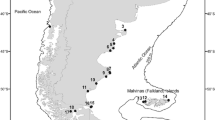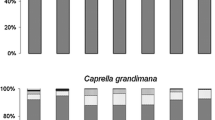Abstract:
The diet of the cuttlefish Sepia officinalis L. was studied from stomach contents. This analysis was carried out on monthly samples throughout the whole biological cycle in the Northern Bay of Biscay focusing on 3 areas: a breeding and hatching area (Morbihan Bay), a winter area (off Belle-Ile island) and a transition area (Morbraz).¶The list of prey species showed that Sepia officinalis an opportunistic predator with a flexible diet that allows it to survive when its usual prey is unavailable.¶The diet is discussed in terms of the repletion ratio (R.R.: number of stomachs with remains/number of stomachs examined as %) and the monthly frequency of a prey species. Results show that R.R. was minimal during reproduction (around 25%) whereas during the rest of the life cycle it was higher than 50%. Amphipods (Phtisica marina) are the main prey for the first 3 months. During the growth period, fish (Ammodytiae, Gobiidae, Gadidae) occupied the first place in the diet. In animals returning to coastal waters for reproduction, the diet changed again and crustacea especially Brachyura (Carcinus maenas, Liocarcinus arcuatus) became the most important prey.
Similar content being viewed by others
Author information
Authors and Affiliations
Additional information
Received 24 November 1998; revised manuscript accepted 13 March 2000.
Rights and permissions
About this article
Cite this article
Pinczon du Sel, G., Blanc, A. & Daguzan, J. The diet of the cuttlefish Sepia officinalis L. (mollusca: cephalopoda) during its life cycle in the Northern Bay of Biscay (France). Aquat. sci. 62, 167–178 (2000). https://doi.org/10.1007/PL00001329
Issue Date:
DOI: https://doi.org/10.1007/PL00001329




